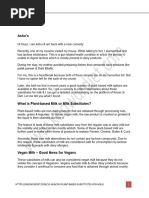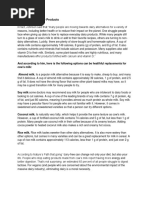Facts
Facts
Uploaded by
GomatheeswariCopyright:
Available Formats
Facts
Facts
Uploaded by
GomatheeswariOriginal Description:
Copyright
Available Formats
Share this document
Did you find this document useful?
Is this content inappropriate?
Copyright:
Available Formats
Facts
Facts
Uploaded by
GomatheeswariCopyright:
Available Formats
Interesting Facts
Regular whole milk contains less than 4% fat. The fat in milk is actually
cream thats why it is sometimes called full cream milk.
Its the protein in milk that makes milk froth. Next time you go to make the
perfect coffee or hot chocolate at home, try using skimmed milk. Because
there is no fat, the protein levels naturally become higher.
A cow udder holds between 25 and 50 pounds of pure milk.
It is difficult to obtain enough calcium without consuming milk.
Goat milk is non-allergenic. Goat milk does not have the protein that is the
main stimulant of allergenic reactions (B-Lactoglobulin)
A cow gives milk for the first time, only after she gives birth to a calf.
A cow produces around 200,000 glasses of milk in her lifetime.
Milk not only re-hydrates the body, but provides a host of beneficial
nutrients and protects teeth at the same time!
Dairy cows provide over 90% of the entire planets milk supply.
Goats milk contains more butterfat than cows milk.
Each different strain of dairy goat yields a different flavour of milk.
Goats milk is the primary ingredient in cheeses like feta, caprino, gevrik,
and rocamadour.
During early explorations of our planet, sailing ships maintained goats
aboard to provide sailors with fresh milk.
Goats milk breaks down during digestion in 20 minutes whereas cow milk
takes a full hour.
There is more calcium in 1 cup of milk than there is in 16 cups of spinach.
One will need to eat more than 48 cups of spinach to get the recommended
daily intake of calcium.
Lactose intolerance is often confused with milk allergies. Lactose
intolerance is not an allergic reaction to dairy foods. Rather it is the
inability to digest the milk sugar lactose. Lactose-free milk and yoghurt are
good alternatives to drinking milk for people that are lactose intolerant.
Aged cheeses such as Cheddar and Swiss are also low in lactose. Many
people with lactose intolerance can drink up to 1 glass of milk daily without
problems.
Milk may actually protect against the formation of kidney stones (NHS,
1990). It was suggested that the calcium in milk may bind to oxalates in
food so that they can no longer be absorbed by the body, reducing the risk
of kidney stones.
Milk is the only drink in the world that contains such a large range of
naturally occurring nutrients. Thats what makes it so unique.
The entire skeleton of a young child is replaced about every two years.
Thats why a childs demand for calcium is so high.
You might also like
- Chemistry Investigatory ProjectDocument14 pagesChemistry Investigatory Projectvaibhav shah75% (16)
- Is Soy Milk Better Than CowDocument3 pagesIs Soy Milk Better Than CowPuia ThanpuiaNo ratings yet
- ChemDocument10 pagesChemthirumalaivasan GNo ratings yet
- Let's Compare Dairy Goats and Cows: Curtis W. RichardsonDocument4 pagesLet's Compare Dairy Goats and Cows: Curtis W. RichardsonPrince AliNo ratings yet
- Facts About Milk 2Document15 pagesFacts About Milk 2hanisah ahmad jaafarNo ratings yet
- AlimarDocument7 pagesAlimarpeutoyessaminNo ratings yet
- The Benefits of Goat MilkDocument3 pagesThe Benefits of Goat MilkSelipar JepunNo ratings yet
- Facts About Milk: Milk by The NumbersDocument4 pagesFacts About Milk: Milk by The Numbershafsasif694No ratings yet
- MilkDocument3 pagesMilkLakmus6No ratings yet
- The Oat Milk Cookbook: More than 100 Delicious, Dairy-free Vegan RecipesFrom EverandThe Oat Milk Cookbook: More than 100 Delicious, Dairy-free Vegan RecipesNo ratings yet
- Sweetened Condensed Milk Nutrition InformationDocument9 pagesSweetened Condensed Milk Nutrition InformationRobert Magana100% (1)
- Prepartion of Soya Milk and Its Comparison With Natural MilkDocument5 pagesPrepartion of Soya Milk and Its Comparison With Natural MilkHimangshuNo ratings yet
- Breast Feeding and Its AdvantagesDocument45 pagesBreast Feeding and Its AdvantagesRajeev NepalNo ratings yet
- The Wonder of Raw MilkDocument2 pagesThe Wonder of Raw MilkrtfemailNo ratings yet
- TedDocument14 pagesTedHải NguyễnNo ratings yet
- 10 Healthy Plant-Based Substitutes for MilkDocument5 pages10 Healthy Plant-Based Substitutes for Milkhatimpatan1234No ratings yet
- Tugas ASIDocument20 pagesTugas ASIMia Mia MiaNo ratings yet
- Milk Sampling ActivityDocument5 pagesMilk Sampling ActivitywilsonNo ratings yet
- Soyamilk Class 12 ProjectDocument29 pagesSoyamilk Class 12 ProjectPrithvi BhushanNo ratings yet
- Bone HealthDocument21 pagesBone Healthvivekpandeyd2No ratings yet
- Topic Preparation of Milk From Soyabean: Name: Sharquia Class: XII F' Roll No.: 35Document14 pagesTopic Preparation of Milk From Soyabean: Name: Sharquia Class: XII F' Roll No.: 35Ayush MallickNo ratings yet
- Milk, Myths andDocument7 pagesMilk, Myths andNoorNo ratings yet
- Fluid Milk ProductionDocument3 pagesFluid Milk ProductionCiprian MocanNo ratings yet
- Class 12 Chemistry Project Curd From Soy MilkDocument16 pagesClass 12 Chemistry Project Curd From Soy MilkAbhinandan Ramkrishnan0% (3)
- Chemistry Milk Activity MaterialDocument3 pagesChemistry Milk Activity MaterialRishan GobseNo ratings yet
- Leaflet - Milk FermentationDocument3 pagesLeaflet - Milk FermentationNoor SultanNo ratings yet
- Which Type of Milk Is Best For You?Document3 pagesWhich Type of Milk Is Best For You?김진솔No ratings yet
- Everyone's Going Dairy-FreeDocument21 pagesEveryone's Going Dairy-FreeVegan Future100% (1)
- Soy Milk RecipeDocument2 pagesSoy Milk RecipeAinna Arina100% (1)
- Milk Proteins Good & BadDocument3 pagesMilk Proteins Good & BadJose PalomarNo ratings yet
- Bio Inv - ProjectDocument12 pagesBio Inv - ProjectnoobNo ratings yet
- MILKEnglish grammar 10thDocument16 pagesMILKEnglish grammar 10thsupraja.ravi.tNo ratings yet
- Chemistry 2Document8 pagesChemistry 2shreyashchakraborty07No ratings yet
- Chemistry 4Document8 pagesChemistry 4shreyashchakraborty07No ratings yet
- What Is Milk?: Milk and Milk ProductsDocument8 pagesWhat Is Milk?: Milk and Milk ProductsErole MissionNo ratings yet
- lDocument19 pagesltamilselvan1405No ratings yet
- MedNewToday_2021.1109_Which milk is best_ Almond, hemp, oat, soy, or cow's milkDocument14 pagesMedNewToday_2021.1109_Which milk is best_ Almond, hemp, oat, soy, or cow's milksy.infosubsNo ratings yet
- 2Document14 pages2anon-934049No ratings yet
- MedNewToday_2019.1204_Dairy milk substitutes_ Soy, almond, and othersDocument13 pagesMedNewToday_2019.1204_Dairy milk substitutes_ Soy, almond, and otherssy.infosubsNo ratings yet
- Milk CompositionDocument1 pageMilk CompositionAndreea Andrei100% (3)
- Types and Chemistry of MilkDocument21 pagesTypes and Chemistry of MilkAira Colleen RebuladoNo ratings yet
- Raw Milk Use and Safety Fact Sheet Science ModuleDocument10 pagesRaw Milk Use and Safety Fact Sheet Science Moduleratih95No ratings yet
- Plant-Based Oat Milk, Its Benefits, Nutritional Facts, and Potential DownsidesDocument5 pagesPlant-Based Oat Milk, Its Benefits, Nutritional Facts, and Potential Downsidesnimra navaira100% (1)
- The New Milks: 100-Plus Dairy-Free Recipes for Making and Cooking with Soy, Nut, Seed, Grain, and Coconut MilksFrom EverandThe New Milks: 100-Plus Dairy-Free Recipes for Making and Cooking with Soy, Nut, Seed, Grain, and Coconut MilksRating: 4.5 out of 5 stars4.5/5 (3)
- Research Alternative For Dairy ProductsDocument5 pagesResearch Alternative For Dairy Productspanjee moyanNo ratings yet
- RH GROUP 5Document11 pagesRH GROUP 5ajayiifeoluwa384No ratings yet
- 7 Benefits of Almond MilkDocument10 pages7 Benefits of Almond MilkJudi Ann Magsacay100% (1)
- Benifits of Cow MilkDocument2 pagesBenifits of Cow MilkAli ZafarNo ratings yet
- Goat Milk, A Divine Superfood!Document3 pagesGoat Milk, A Divine Superfood!S. Zook, MS, PhD100% (6)
- Camel MilkDocument2 pagesCamel MilkzeinaorensaNo ratings yet
- MilkDocument2 pagesMilkthivanaNo ratings yet
- Preparation of Soyabean Milk and Comparision With Natural MilkDocument9 pagesPreparation of Soyabean Milk and Comparision With Natural MilkamanNo ratings yet
- Malta Dair Products LTDDocument5 pagesMalta Dair Products LTDGabriella CauchiNo ratings yet
- Cheese MakingDocument4 pagesCheese Makingmingix420No ratings yet
- ankit bklDocument15 pagesankit bkltheprovediNo ratings yet
- 19 Miiilk Composiiitiii On and Nutriiitiiional ValueDocument4 pages19 Miiilk Composiiitiii On and Nutriiitiiional ValueOsman AitaNo ratings yet
- Breast Cow Milk CompareDocument2 pagesBreast Cow Milk CompareEm AlcantaraNo ratings yet
- Exclusive BreastfeedingDocument6 pagesExclusive BreastfeedingDezttie IdEss Ndess100% (1)
- Oct 15-Sep-16 GraphDocument2 pagesOct 15-Sep-16 GraphGomatheeswariNo ratings yet
- Meat Species IdentificationDocument33 pagesMeat Species IdentificationGomatheeswariNo ratings yet
- TNSCST ProposalDocument11 pagesTNSCST ProposalGomatheeswariNo ratings yet
- Criteria For Effective TeacherDocument2 pagesCriteria For Effective TeacherGomatheeswariNo ratings yet
- Pre-Registration Form International Conference On "Role of Biomolecules in Food Security and Health Improvement" andDocument1 pagePre-Registration Form International Conference On "Role of Biomolecules in Food Security and Health Improvement" andGomatheeswariNo ratings yet
- Week Date Production Total Stock Sales Receipt (RS)Document8 pagesWeek Date Production Total Stock Sales Receipt (RS)GomatheeswariNo ratings yet
- Time Table 16-17 BatchDocument2 pagesTime Table 16-17 BatchGomatheeswariNo ratings yet
- Competency Enhancement For Effective Teaching: (November 18 - December 15, 2016)Document2 pagesCompetency Enhancement For Effective Teaching: (November 18 - December 15, 2016)GomatheeswariNo ratings yet
- VPE Question BankDocument23 pagesVPE Question BankGomatheeswari100% (1)
- Immunoglobulin ELISA KitsDocument3 pagesImmunoglobulin ELISA KitsGomatheeswariNo ratings yet
- Renewal Application FormDocument1 pageRenewal Application FormGomatheeswariNo ratings yet
- Milk Production TamilnaduDocument14 pagesMilk Production TamilnaduGomatheeswariNo ratings yet
- Quotation: Item Code List Price (RS) Quantity Discount % Description Price (RS) Unit PriceDocument2 pagesQuotation: Item Code List Price (RS) Quantity Discount % Description Price (RS) Unit PriceGomatheeswariNo ratings yet
- Canine IgG InsertDocument2 pagesCanine IgG InsertGomatheeswariNo ratings yet









































































